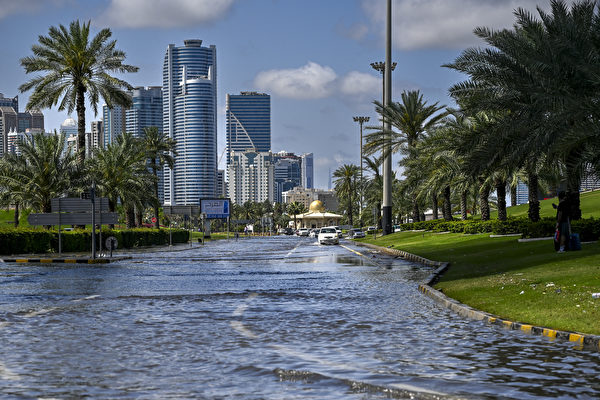The United Arab Emirates (UAE) experienced its most severe rainfall in 75 years, with some areas receiving over 250 millimeters of rain in less than 24 hours, causing chaos across the country.
The heavy rains flooded streets, uprooted palm trees, and destroyed building facades. This Middle Eastern country has not seen such rainfall since records began in 1949. In the popular tourist destination Dubai, flights were canceled, transportation was disrupted, and schools were closed.
According to airport weather observations, there was approximately 100 millimeters (almost 4 inches) of rainfall within just 12 hours on Tuesday. This is roughly the amount of rainfall Dubai receives in an entire year, according to United Nations data.
The rain fell heavily and swiftly, causing floods, turning roads into rivers, and forcing some drivers to abandon their vehicles.
This rainfall is attributed to a large storm system crossing the Arabian Peninsula and spanning the Gulf of Oman. A similar system has brought unusually wet weather to neighboring Oman and southeastern Iran.
Oman’s National Emergency Management Agency stated that flash floods triggered by heavy rain have resulted in at least 18 fatalities. Reports from Oman’s state news agency include casualties among school children.
In Ras Al-Khaimah, UAE, police reported on Tuesday that a 70-year-old man died after his vehicle was swept away by floodwaters.
Posts on UAE media and social media show significant damage in parts of the country, including collapsed roads and homes submerged in water.
On Tuesday, social media posts depicted roads and parking lots submerged in water, with some vehicles completely submerged. Parts of Sheikh Zayed Road, a 12-lane highway running through Dubai, were partially flooded, leading to hours-long traffic jams.
On Wednesday, people attempting to enter Dubai city center by road were stranded on highways. Some taxi drivers refused to transport commuters due to road blockages. Some of the stranded individuals had traveled to Dubai from abroad to attend the upcoming World Blockchain Summit scheduled for early next week.
The worst floods in decades have caused severe damage to Dubai Airport, prompting the world’s second busiest airport to advise travelers to avoid unless absolutely necessary.
The airport announced on X that due to weather conditions, it was experiencing severe disruptions, including flight delays, diversions, and impacts on flight crew.
Passengers are urged to check their flight status before arriving at the airport. The center added that efforts were underway to restore operations as quickly as possible.
The National Center of Meteorology stated that the UAE received approximately 256 millimeters of rainfall on Tuesday, the highest in 75 years.
UAE airlines, citing adverse weather and road conditions, suspended check-in procedures for passengers departing from Dubai from early morning to midnight on Wednesday. Delays in departures and arrivals are expected. The airport website showed significant delays of several hours for some arriving and departing flights.
“We are working diligently under very difficult conditions to resume operations as soon as possible,” the airline stated, adding that passengers arriving in Dubai and transiting will continue their check-in procedures.
According to 2023 data from the International Air Transport Association, the airport is the world’s second busiest by passenger traffic, behind only Hartsfield-Jackson Atlanta International Airport in the United States.
On Wednesday, the rainfall continued moving eastward, affecting southern Iran and parts of Pakistan, areas that typically receive little rainfall this time of year. The city of Chabahar in Iran’s Sistan and Baluchestan provinces recorded 130 millimeters of rain.
The Oman’s Times reported that more rainfall was expected on Wednesday.

